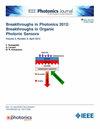用于多输入多输出 FSO 通信的广义湍流信道的新近似分布
IF 2.1
4区 工程技术
Q3 ENGINEERING, ELECTRICAL & ELECTRONIC
引用次数: 0
摘要
本文基于${\bm{\kappa }}分布,为里氏非零孔径指向误差随机变量之和开发了一种创新的序列表示方法。- {\bm{\mu \ }}$ 分布,首次适用于多输入多输出(MIMO)传输。然后,利用这种新表示法,我们为具有广义指向误差和大气衰减的 MIMO 自由空间光学(FSO)通信的 Gamma-Gamma 随机变量之和引入了一种新的闭式概率密度函数(PDF)近似。Kolmogorov-Smirnov 统计测试证实了该近似值在各种信道条件下的准确性。通过使用 Meijer 的 G 函数推导出宏容量、中断概率和平均误码率 (BER) 的闭式表达式,强调了这一近似值的重要性。本文全面分析了利用等增益组合(EGC)分集技术的 MIMO FSO 系统在各种条件下的性能,如不同的发射器和接收器数量、湍流强度、非零孔径指向误差的影响以及路径衰减。研究结果表明,与其他分集技术(包括单输入单输出(SISO)和多输入多输出(MISO)系统)相比,使用具有更多发射器和接收器的多输入多输出(MIMO)技术可显著提高 FSO 通信的性能。对高信噪比情况下的遍历容量、中断概率和平均误码率性能的详细评估提供了更多启示。蒙特卡洛模拟结果证明了所提方法的准确性。本文章由计算机程序翻译,如有差异,请以英文原文为准。
Novel Approximate Distribution of the Generalized Turbulence Channels for MIMO FSO Communications
In this article, we develop an innovative series representation for the sum of Rician non-zero boresight pointing error random variates based on the
${\bm{\kappa }} - {\bm{\mu \ }}$
求助全文
通过发布文献求助,成功后即可免费获取论文全文。
去求助
来源期刊

IEEE Photonics Journal
ENGINEERING, ELECTRICAL & ELECTRONIC-OPTICS
CiteScore
4.50
自引率
8.30%
发文量
489
审稿时长
1.4 months
期刊介绍:
Breakthroughs in the generation of light and in its control and utilization have given rise to the field of Photonics, a rapidly expanding area of science and technology with major technological and economic impact. Photonics integrates quantum electronics and optics to accelerate progress in the generation of novel photon sources and in their utilization in emerging applications at the micro and nano scales spanning from the far-infrared/THz to the x-ray region of the electromagnetic spectrum. IEEE Photonics Journal is an online-only journal dedicated to the rapid disclosure of top-quality peer-reviewed research at the forefront of all areas of photonics. Contributions addressing issues ranging from fundamental understanding to emerging technologies and applications are within the scope of the Journal. The Journal includes topics in: Photon sources from far infrared to X-rays, Photonics materials and engineered photonic structures, Integrated optics and optoelectronic, Ultrafast, attosecond, high field and short wavelength photonics, Biophotonics, including DNA photonics, Nanophotonics, Magnetophotonics, Fundamentals of light propagation and interaction; nonlinear effects, Optical data storage, Fiber optics and optical communications devices, systems, and technologies, Micro Opto Electro Mechanical Systems (MOEMS), Microwave photonics, Optical Sensors.
 求助内容:
求助内容: 应助结果提醒方式:
应助结果提醒方式:


